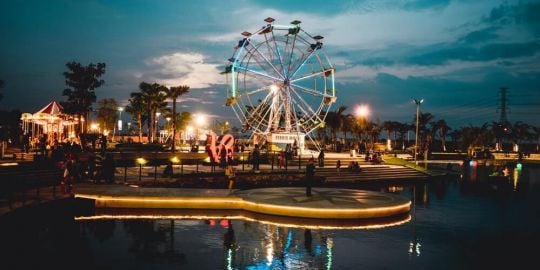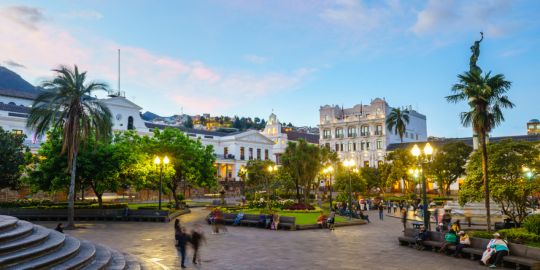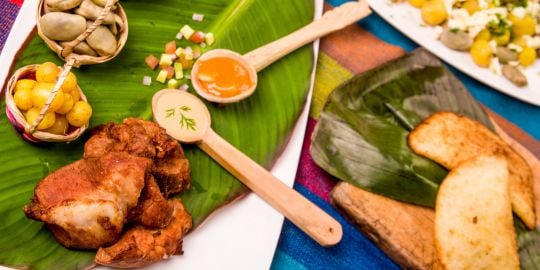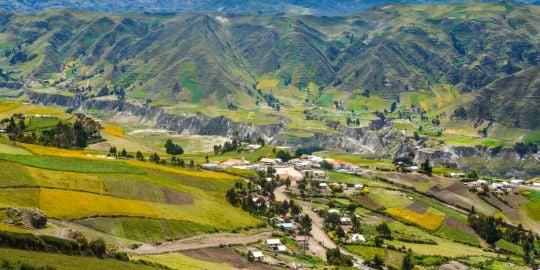Hi everyone,
Do you follow fashion trends in Ecuador? Every country and every culture has its own dress code. As far as you are concerned, have you changed the way you dress?
Can one easily find fashion boutiques in Ecuador? Are clothes expensive there? Or cheap?
What do Ecuadorians usually wear or like to wear the most?
Share your experience!
Priscilla
Following fashion in Ecuador
Oh fashion, shoes and purses, right up my alley!! Love them all. I would also throw makeup and toiletries into this one.
Here is my opinion on this topic. Being a business professional my whole life, my wardrobe choices for the most part have been more on the conservative side, even leisure wear, so most of my clothes really don't go out of style. However, I have found here in ecuador that clothes stores in the mall in Manta do try to mimic the global fashion industry. The fits are different as I have tried on a few things. Living here almost 4 years, I have only purchased one article of clothing and 2 pair of flip flops, which I needed to go on my wedding trip to Fiji. I bought the flip flops at the Tommy Hilfiger store in Quito and they cost me a little more than $150, and that was 3 years ago. When I left the US, I gave away bags and bags of clothes. The packers had left quite a bit of stuff in my house unbeknownst to us and my renters put it in a storage facility. When we sold our house last year and I went for the first time to our storage locker, I found boxes and boxes of clothes and not cheap ones. Having no luggage space to bring back, I filled my realtors (& former neighbor's) BMW X5 SUV completely full, to donate to charity. With that being said my husband and myself still have 4 out of 5 closets in my house full of clothes & shoes. I was able to give away lots after the earthquake so some clothes did come in handy.
I save my clothes and shoe purchases for when I go back to visit Florida on supply runs, as here the colors and fit are not my taste. Plus, my new favorite jeans I bought at Walmart on the clearance rack for $7 last year. (I hated and never shopped at Walmart while living in the states, but sure miss it now). Panama is a great place to buy shoes and clothes but the fit can also be challenging but they do have all the name brands we are used to and prices not so bad. I have bought quite a few things there, including my makeup brand. BUT I have found that I really now living here mostly wear the same things over and over, so I don't need new clothes and shoes anymore. I try not to draw any attention to myself when going out and just fit in. Plus let's be honest, I'm married now, and don't need to dress to impress, lol.
However, being very fair complected makeup is almost impossible for me to find here. Plus I have very sensitive skin on my face and have to be careful in the brands I choose. So my makeup even in the US is expensive. Try having to explain to your husband why you spent almost a $1,000 on makeup to your husband when you go on a supply run. But I keep in my personal inventory enough to last me at least 2 years. I hardly ever wear makeup anymore either cause I can't afford to waste it since I can't get it here. I make most of my skin care stuff now from coconut and essential oils, which aren't cheap either, but at least my skin is ok and doesn't suffer from being overly sensitive. Since I have blonde hair, hair color is tough for me here also. I have had it done her in manta professionally quite a few times and always had to pay close to a $100 for them to never listen to me that my hair processes quickly, and that my scalp is burning. I have had my scalp almost blistered and my hair always ends up with a reddish orange tint from being over processed. So I now do it myself. Had a professional tell me what to do and I go to Sally's when I'm in the US and buy a years worth of color and toner to do my own hair. If you get it on sale the math comes out to $3 a hair color. My husband now loves the job of applying it to my hair and I think secretly is disappointed now when I just do it myself. Who knew that would ever happen? I have learned all that stuff isn't really as important as we are conditioned to think from a very young age in the states. I only wish that I now had all the money that I have spent on this stuff in a lifetime in my pocket now. But don't get me wrong when I vacation away from here i still have a luggage bag just for my shoes I take, but find wearing heels here in manta nearly impossible. Plus it's ridiculous the amount of clothes hanging in my closets that still have the price tags attached.
Plus not having access to all of our favorite processed foods, we have both lost a lot of weight and half our stuff doesn't even fit. I keep it all just in case I ever go back and if I work again I still have my work clothes to wear, and not have to buy all over at least in the beginning. And if I ever need to give away after another disaster I can and will. Although I won't have the extra towels and sheets to give away anymore.
So yes you can find the latest styles here but they don't always fit our body type and they can be very expensive. Don't even get me started on the perfume/cologne prices here. They are insane and yes when I have had to have paid the enormous prices. But now that's also in my inventory I keep on hand. I have 2 great supply closets and some of my friends have already put dibs on stuff they want to buy if I ever leave here.
When I was planning to move here and my husband was already living here, I asked one of my closest male friends and coworker at the time if he thought I would make it living here. He laughed and said I don't know, how are you at adapting. I remember looking at him perplexed and saying what do you mean? And he said how are your adaptable skills? And I again said I have no idea what you are talking about, because I have never had to. Short answer, I now know exactly what he was talking about and trust me they were not very good at all, but it has been a nonending learning experience.
post deleted by poster...
Reason: inadvertently 

Do you follow fashion trends in Ecuador?
Yes, but to some extent, and certainly not obsessed by it, I'll read an article in a newspaper or magazine, and also notice a type of fashion being pushed on the streets and know why.
Every country and every culture has its own dress code. As far as you are concerned, have you changed the way you dress?
I've embraced what Ecuador has to offer, last week I bought a leather jacket, before that cowboy boots, and also a wool jacket, all handmade in Ecuador. It doesn't get better than the Andes for the fashionably conscious. It's spring and fall all day and it's perfect for dark colors.
Can one easily find fashion boutiques in Ecuador?
Thankfully nothing is obvious here, this is a subtlety that I love about Quito, but there are boutiques, many actually with some having items by specific designers.
Are clothes expensive there? Or cheap?
If we're going to compare to the USA, like many like to do here then yes clothing is much more expensive. But for high quality items like leather products and alpaca, you can get such items for about half the cost of similar products in North America and Europe. This is true if you know your stuff and know how to bargain. For example there are leather products for the local market/tourists, and export. The export quality is the best.
We also have Zara (European fashion) at Quicentro and while most places there are outrageously priced, Zara's prices are identical to outlets in North America and Europe. It's my favorite place here as it's not pretentious and the european sizes fit my body perfectly.
What do Ecuadorians usually wear or like to wear the most?
Very modest for the most part with almost everyone wearing jeans. The ladies like to wear them tight. Tops are also modest with t-shirts, sweaters, jackets that are mostly non-brand or fakes. But there is a minority that dresses quite fashionably. It's obvious on the streets of La Carolina east side, cafes and trendy restaurants.
Personally, I'm fashion conscious. How I dress is a reflection of who I am. Quito is perfect for that, a pair of jeans and blazer for coffee in the morning or afternoon/evening for Michelada harmoniously fits with my area.
How to find and buy good quality leather products in Ecuador?
The key is to know exactly what good leather is and how to differentiate between hide qualities. There are online guides that one can learn from and that would be a good place to start. The quality of the leather is one aspect but the workmanship by the artisan is also extremely important. Again, there are guides online to understand how to tell what's good work, but in general you want to judge the finish of a product. If it's a jacket, look at the stitching, lining, symmetry, buttons, zipper, and fit among other details. A good jacket should last a very long time or many years, and you have to ask yourself this question, will it last many years?
Determining prices to getting a fair price you can start with Mercado libre for a general sense, but you actually have to see and touch the product. Keep in mind there are leather jackets on Amazon (and boots too) and they might look similar to what you can buy here. But read some of those reviews and they'll state the jacket feels too light, flimsy and that the stitching started coming out. So it's not just about the look but the actual quality. Put it this way you will not be able to buy a $300-$400 jacket for $75, and as much as naive tourists think so, this is not true at all. It takes time to make a high-quality product and there is an export market for these higher end products. A quality artisan will not sell their quality work for a low sum. This is true for jackets, boots, shoes, and other items.
The leather jackets that you see some locals wearing, those are in the $50-$70 range. The same thing with boots, there's $75 quality, $150 quality and La Mundial boots which can cost several hundred. For custom made La Mundial boots the waiting time can be a few months because of high demand.
So, visit Otavalo market, Cotacachi and other locations that sell leather then visit artisans shops and see the difference, but do keep in mind that artisans are not all alike. Some might sell a wide variety of products but are only really good in making certain items. If you live here the exploration should be fun and if you're visiting then perhaps visit some of the leather shops in Quito first before going to other cities to compare. You can begin on Amazonas in La Marsical there is a stretch there of shops that sell leather products.
The local men wear long pants in the high-altitude capital, Quito, except if playing fútbol or participating in other active sports.
Wearing shorts on the street is a sure way to announce to Quiteños that you are a Gringo who is either clueless .. or proud of his Gringo-ness -- and probably clueless as well. 
cccmedia
I think they're clueless aswell, especially the ones with the complete gringo gear, like wearing a safari hat with flaps hanging down the back of the neck. I think they would definitely fail the Empanada-cart test.
This is a very simple test.
Go to an Empanada cart during breakfast time or early evening when it's teeming with hungry Ecuadorians standing around eating. Order an Empanada, and coffee if you like, stand there eating the Empanada with Ecuadorians all around. If you attract attention, then return home and make a better effort at blending in.

Modest? Long pants? $150 flip flops?
Definitely NOT the Coast!
Here in Montañita less, much less, is more.
Cut offs and a T-shirt is my uniform usually over a bathing suit. And sunglasses.
Boutiques? All around plus shops selling bathing suits and beachwear.
Lots of skin on beach bodies of all shapes, sizes and ages.
And the prices are very reasonable too ($25 for a double room, a meal for $6, and cocktails 3 for $10)
From Guayaquil the bus is $6 and takes 3 hours (CLP)
Come to the beach, you know you want to!
Cuenca has an interesting mix of styles and fashion. Much of it is based on social class. There are tons of overly tight t-shirts and leggings on the tienda and mercado women. Men of the same socio-economic class seem fond of free t-shirts that advertise all sorts of things, as well as track pants and plastic flip-flops are de rigeur.
You also have a lot of traditional dress (the chola Cuencanas in their colourful layered skirts lacy blouses and paja toquillas) as well as Cañaris with their felt hats, short pants and long braids on the men.
As you move up the classes, the women still seem to prefer tight clothes (even their employers do, as many wear uniforms to work) with very short skirts and mind bogglingly high heeled shoes. (I used to wear similar shoes when I was at work, but with less of a platform.) The clothes in the tiendas tend to be tight, polyester with lots of sparkles and cut outs. It doesn't seem to matter if your bra shows through your shirt at all here. It seems almost imperative that your shoes match your shirt for women and occasionally men. Dress shirts and dress pants seem to be required for shop owners and sales people. To advertise sales, they aren't afraid to tot young girls up in lycra outfits and teetering heels as well.
When you get into the professional class of well to do the clothes are slightly looser (but not much - no fears of embarrassment over muffin tops here). The heels are just as high for women and the men add ties and nice shiny leather shoes, pocket squares and pinky rings. Older gentlemen still sport hats, tie clips and other stylish accessories.
If you are buying imported clothes they can be quite expensive, but you can have almost anything tailor made at a reasonable price and it's fairly easy to pick up inexpensive t-shirts, shoes and other items, if you are fussy about materials.
PEI Red wrote:Cuenca has an interesting mix of styles and fashion. Much of it is based on social class. There are tons of overly tight t-shirts and leggings on the tienda and mercado women. Men of the same socio-economic class seem fond of free t-shirts that advertise all sorts of things, as well as track pants and plastic flip-flops are de rigeur.
You also have a lot of traditional dress (the chola Cuencanas in their colourful layered skirts lacy blouses and paja toquillas) as well as Cañaris with their felt hats, short pants and long braids on the men.
As you move up the classes, the women still seem to prefer tight clothes (even their employers do, as many wear uniforms to work) with very short skirts and mind bogglingly high heeled shoes. (I used to wear similar shoes when I was at work, but with less of a platform.) The clothes in the tiendas tend to be tight, polyester with lots of sparkles and cut outs. It doesn't seem to matter if your bra shows through your shirt at all here. It seems almost imperative that your shoes match your shirt for women and occasionally men. Dress shirts and dress pants seem to be required for shop owners and sales people. To advertise sales, they aren't afraid to tot young girls up in lycra outfits and teetering heels as well.
When you get into the professional class of well to do the clothes are slightly looser (but not much - no fears of embarrassment over muffin tops here). The heels are just as high for women and the men add ties and nice shiny leather shoes, pocket squares and pinky rings. Older gentlemen still sport hats, tie clips and other stylish accessories.
If you are buying imported clothes they can be quite expensive, but you can have almost anything tailor made at a reasonable price and it's fairly easy to pick up inexpensive t-shirts, shoes and other items, if you are fussy about materials.
The well to do in Quito basically dress in American or European brand fashion. For example some women wear tight jeans and a cardigan with shoes/sneakers/boots, with bras hidden. 
I'm absolutely convinced it's not solely about money because some people are quite fashionable with modest incomes, and others while wearing seemingly expensive items simply don't get it and look tacky.
Visit La Carolina east side, walk along República del Salvador, Portugal, Luxemburgo, Suecia, etc, it's quite trendy. The contrast in fashion if it confuses people is simple, there are residents of this area and there are people who only work here and travel south or north after work. There are also many local tourists as it's a fun area, but the residents dress quite well in European fashion.
Cuenca does't have trendy areas with trendy people?









